What Is A Good Conversion Rate? (& How To Improve It)
Are you interested in learning what is a good conversion rate and what options you have to improve it?
If you’re curious about how well your online efforts pay off, conversion rates (CRs) are the key to understanding your success.
And if you’re not tracking the conversion rate for the specific action, you might be leaving a lot of money on the table.
The action could be anything, from signups and sales to downloads, you name it.
What’s important to note is that tracking conversion rates is an ongoing process. Whether your CR is high or low, there’s always room for improvement.
In this article, you’ll find out the following:
- The Importance Of Conversion Rate For Your Businesses
- How Do You Calculate Your Conversion Rate?
- What Is A Good Conversion Rate?
- 7 Factors Affecting Conversion Rate
- 10 Ways How To Improve Your Conversion Rate
- Conclusion: Remember Conversion Rate!
Spoiler alert: A good website conversion rate is between 2% and 5%. (But scroll down to find a more detailed overview and benchmarks.)
The Importance Of Conversion Rate For Your Businesses
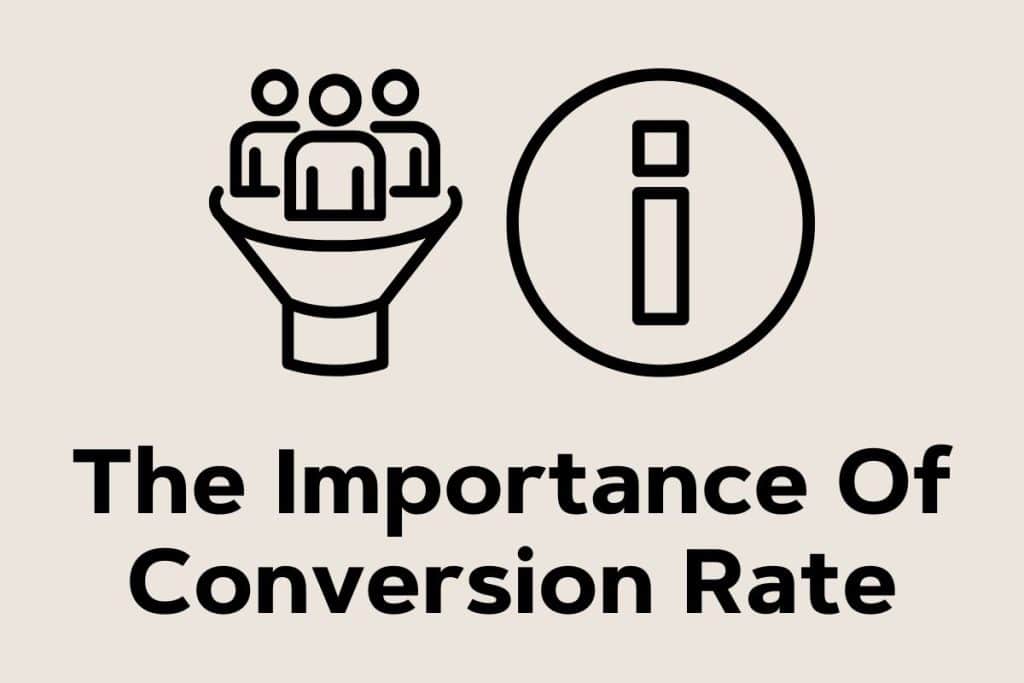
Running a business blindly without knowing the conversion rate won’t take you very far. Sure, you may see some results, but you’ll be far behind the competition that takes CR analysis seriously.
Conversion rate directly impacts your bottom line and determines the effectiveness of your marketing and sales efforts.
Let’s check some of the key reasons why conversion rate matters and why you shouldn’t overlook it:
Revenue Generation
A high conversion rate means more customers are taking desired actions, such as making purchases, signing up for services, or becoming subscribers.
This directly translates into increased revenue and business growth.
However, it’s also important to mention that a high conversion rate on low-quality leads might do more harm to your business than good.
Thus, regularly checking lead quality is a must so that you can adjust and optimize your marketing efforts accordingly.
Cost Efficiency
Improving your conversion rate allows you to make the most bang for your marketing budget.
By converting a higher percentage of your website visitors or leads into customers, you maximize the return on your investment and reduce customer acquisition costs.
If you spend $1,000 to bring in 10,000 readers that generate 100 click-throughs, your conversion rate is only 1%, and you’re paying $10 for every conversion.
On the other hand, if you increase click-throughs to 200, your CR improves to 2%, but your spend per conversion decreases to $5.
Performance Evaluation
Conversion rate is a measurable metric to assess the effectiveness of your marketing campaigns, landing pages, and overall user experience.
It helps identify areas for improvement and optimization to refine your strategies and reap better results.
Customer Insights
Analyzing conversion rates provides valuable insights into customer behavior, preferences and pain points.
This gives you a better understanding of what drives and hinders conversions to better tailor your marketing campaigns, messaging and offerings to positively impact more customers.
Know your audience, thanks to CR!
Competitive Edge
A higher conversion rate gives you a competitive advantage in your industry.
It indicates that you are providing a compelling value proposition and delivering an exceptional customer experience, setting you apart from competitors.
Ultimately, a good conversion rate means turning more prospects into paying customers, increasing revenue, and growing your business.
We know by now that it is a key performance indicator that should be monitored, analyzed and optimized for long-term success.
How Do You Calculate Your Conversion Rate?

Before we continue, let me explain conversion rate in one sentence: Conversion rate is the percentage of website visitors or users who take a desired action.
Example: If twenty people out of 1,000 convert, your conversion rate is 2%.
So how, then, do you calculate CR?
You divide the number of conversions/desired actions by the total number of visitors or users to your websites, landing pages, opt-in forms, etc.
You then take that number and multiply it by one hundred. This gives you the conversion rate in percentage.
From our example above, that would mean: 20 / 1,000 x 100 = 2%.
Here are some more examples of calculating conversion rates for specific actions:
- Sales conversion rate: Number of sales / number of visitors x 100
- Website conversion rate: Number of conversions / number of website visitors x 100
- Subscriber conversion rate: Number of subscribers / number of website visitors x 100
- Lead generation conversion rate: Number of leads / number of visitors (to the opt-in form) x 100
- Email conversion rate: Number of click-throughs or purchases / number of email recipients x 100
- Marketing ad conversion rate: Number of clicks or purchases / number of of ad views x 100
What Is A Good Conversion Rate?

Determining what constitutes a good conversion rate can be subjective and depends on various factors such as industry, business model and specific goals.
In plain English, there’s no good CR that everyone can use as a benchmark. Hey, conversion rates vary even within the specific industry or niche because every business and its audience differs slightly.
However, we researched multiple industries for those into numbers, so you can see whether you’re far behind or ahead of what’s considered a “good conversion rate.”
Hint: Instead of focusing on industry averages, tracking your conversion rate over time and setting incremental improvement goals is more valuable.
Testing and optimizing never stop if you want to enjoy epic success.
Industry-Specific Benchmarks
If we peek at the fourteen industries Ruler Analytics covers in their article, the average industry-specific conversion rate is 2.9%.
As you can see from the table below, the average CR varies significantly across all industries.
| Industry | Average conversion rate |
| Professional services | 4.6% |
| Industrial | 4.0% |
| Auto | 3.7% |
| Legal | 3.4% |
| Finance | 3.1% |
| Dental & cosmetics | 3.1% |
| Healthcare | 3.0% |
| B2B services | 2.7% |
| Real estate | 2.4% |
| Travel | 2.4% |
| B2B tech | 2.3% |
| Agency | 2.3% |
| B2C | 2.1% |
| B2B eCommerce | 1.9% |
eCommerce Conversion Rate
According to IRP Commerce, the average conversion rate for eCommerce in May 2023 was 2.02%, which is a 0.20% improvement since the month before. Note that this is the average CR across all eCommerce markets.
As of May 2023, health and wellbeing is the eCommerce sector with the highest conversion rate, followed by arts and crafts.
Surprisingly, the baby and child category had the lowest CR, followed by home accessories and giftware.
Let’s now look at particular sectors:
| eCommerce market | Average conversion rate |
| Arts and crafts | 4.46% |
| Baby & child | 0.80% |
| Cars and motorcycling | 1.37% |
| Electrical & commercial equipment | 1.23% |
| Fashion clothing & accessories | 1.55% |
| Food & drink | 1.36% |
| Health and wellbeing | 5.40% |
| Home accessories and giftware | 1.03% |
| Kitchen & home appliances | 2.77% |
| Pet care | 2.09% |
| Sports and recreation | 1.77% |
| Toys, games & collectables | 1.51% |
Lead Generation Conversion Rate
When compiling our extensive lead generation statistics, we discovered that the average CR across 14 industries is 2.9%.
Healthcare, dental and cosmetics, industrial and legal have some of the highest CRs, while B2B tech and B2B services the lowest.
But it’s also important to note that conversion rates don’t vary only per industry but also depend on the quarter.
Some have the highest CR in Q1 (legal, 5.3%), some in Q2 (industrial, 5.8%), some in Q3 (healthcare, 5.4%) and some in Q4 (dental and cosmetics, 7.0%).
Content Marketing Conversion Rate
While content marketing can improve conversion rates by multiple 100%s, the default average CR is only around 1% for B2B. And when looking at B2C content marketing campaigns, the average CR is even lower.
Don’t miss our epic content marketing statistics to find out how many content marketers there are and more.
SaaS Conversion Rate
The SaaS CR can vary quite a bit depending on the business model. For instance, SaaS companies that offer free trials usually see a much higher conversion rate – around 15% to 20%.
The drop in CR is significant when it comes to freemium models (3%-5%) and enterprise sales (around 7% and under), but that is expectable.
Curious about which traffic source works best for SaaS conversions? Email (2.3%), organic search (1.9%) and organic social (1.4%).
Even though there’s no universally defined CR benchmark for SaaS, it’s worth mentioning that the rate is usually higher because these businesses often focus on pushing a single product or service.
Interested in learning more about SaaS? Then check out our SaaS statistics.
Email Conversion Rate
The conversion rate for email can go from 1% to around 4%, depending on the industry.
2.6% is the average across fourteen industries, with the highest having automotive and real estate sectors and the lowest B2C services, financial and agency.
But even within each sector, conversion rates vary based on the quarter. For instance, the automotive market will have a 3.9% CR in Q1, 3.5% CR in Q2, 3.9% in Q3 and CR 4.2% CR in Q4.
You should also know that email open rates (approx. 20%) are much higher than click-through rates (approx. 4%).
Have you ever wondered how many people use email? Our extensive email marketing statistics reveal it all.
Landing Page Conversion Rate
The average conversion rate of landing pages is approximately 6%, but there are high-achievers with CRs even above 20%. However, achieving results like this takes time, careful performance analysis and optimization.
When looking at specific industries, we found that catering and industry landing pages get one of the highest CR at nearly 10%. The other two leading industries with high conversion rates are media and entertainment and finance (8%) and insurance (6%).
On the other side are low-performing industries, like home improvement (4%), travel and events (5%) and leisure (5%).
Don’t forget to study our landing page statistics to discover how successful using “landers” is.
High Conversion Rate Examples
- By adding an opt-in email popup on the pricing page, Hotjar generated 400+ leads in the first three weeks.
- A slide-in box made the HubSpot blog improve its click-through rate by 192% and score 27% more submissions compared to a standard call-to-action (CTA).
- After implementing A/B testing, China Expat Health increased its lead conversion rate by nearly 80% (without increasing the traffic volume!).
- A retargeting strategy (to a select audience) involving a 15-second YouTube video ending with a call-to-action contributed to United Airlines‘ 52% of click-through conversions directly from the ad.
- When Replacements, Ltd. introduced simple cart abandonment reminders, they gained $101,000 in additional revenue in the first four months.
- A 100ms mobile page load enhancement improved Deloitte’s conversion rate by 1%.
- Proof used “hot streaks” to show how many people signed up for their services in the “last 24 hours,” resulting in a 53% conversion rate increase.
- A website redesign (after the first failed attempt) OROS successfully enjoyed a 60% increase in sales.
- By implementing a content marketing strategy, Pomelo Pay enhanced its blog traffic by 200%+ and total leads by 700%.
- By mastering the value proposition messaging, Corgi HomePlan experienced a 120% increase in mobile CR. Not just that, but they also enjoyed a nearly 60% rise in customer signups and a 21% reduction in abandonment at checkout.
Device-Related Conversion Rates
While optimizing for mobile is one of the most important feats every marketer should master, conversion rates on desktop are still much better.
It’s likely because of the larger screens and because mobile users get hit by various distractions from all over the place.
| Device | Average conversion rate |
| Mobile | 1.82% |
| Tablet | 3.49% |
| Desktop | 3.90% |
Traffic Source-Related Conversion Rates
In a report by FirstPageSage, we can see that B2C email and B2B organic search have the highest average conversion rates.
| Traffic source | B2C conversion rate | B2B conversion rate |
| Organic search | 2.1% | 2.6% |
| Paid search | 1.2% | 1.5% |
| 2.8% | 2.4% | |
| Direct | 1.6% | 1.9% |
| Referral | 1.8% | 1.1% |
| Organic social | 2.4% | 1.7% |
| Paid social | 2.1% | 0.9% |
| Paid ads | 0.7% | 0.3% |
Furthermore, when comparing traffic sources and target audiences, conversion rates of small businesses and SMEs are higher compared to enterprise organizations.
7 Factors Affecting Conversion Rate
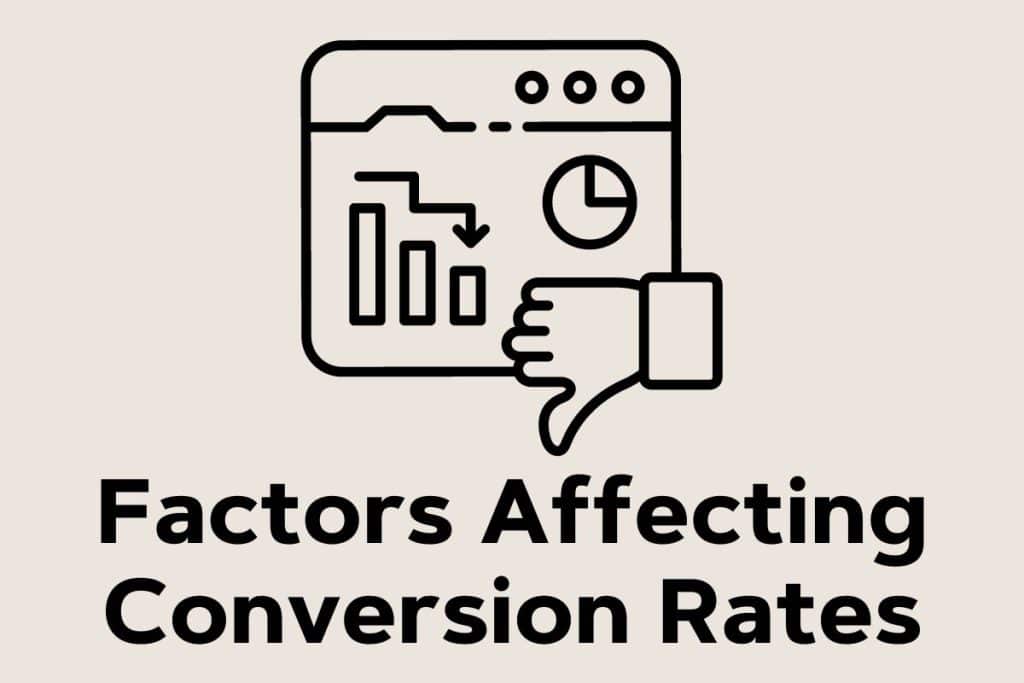
1. Website design and user experience
The first thing we need to start with are website design and user experience. It’s something you might not nail right away, but that’s okay. That’s when studying performance and optimization come into play.
The negative impact of website design and user experience can affect the conversion rate performance greatly.
Here’s how:
- Increased bounce rate. When your website design is all over the place (even the design of newsletters, landing pages, ads, etc.), people won’t engage with your content as much as they could and take the desired action. They will bounce (or not take action) as soon as something annoys them. Thus, your chance of converting them into customers goes DOWN big times.
- Lower trustworthiness. Poor design, outdated graphics, lack of branding consistency and broken links can all create a negative impression and erode trust. Your website will relate win unprofessionalism, so they will be less likely to provide personal information or make a purchase.
- Slower loading times. Users expect websites to load quickly; if they experience long loading times, they are more likely to abandon the site. That’s the brutal truth.
- Unresponsiveness. With the increasing use of mobile devices, a website not optimized for mobile can result in a poor user experience. This can cause challenging viewing, navigation and interaction with the site.
- Difficulty finding information. You MUST ensure that everyone finds everything easily and quickly. Don’t cause stress with finding product details, pricing, or contact information. Clear, intuitive and well-organized content is crucial for guiding users and helping them find what they want. This brings us to:
- Weak navigation. Whether it’s on mobile or on desktop, your site navigation needs to be easy to understand and easy to access. Sticky navigations and mega menus work great. But for a simple blog, a drop-down will do the trick.
Don’t frustrate your audience; excite and inspire them instead. Yes, through your epic website design and superb user experience.
2. Call-To-Action Optimization
Because of the importance of call-to-actions, I’m adding them as a separate point because they’re one of the key factors that affect (positively or negatively) the conversion rate.
Weak or poorly placed (inconsistent or confusing) CTAs can puzzle users and hinder their ability to take the desired actions.
CTAs should be visually prominent, clearly communicate the next step, and align with the user’s expectations and intentions.
Friendly tip: CTAs are one of the first elements you should split-test.
3. Target Audience And Customer Segmentation
Target audience and customer segmentation play a crucial role in influencing conversion rates. If you don’t know your audience – well, you have a lot of work to do.
Identifying and understanding your target audience allows you to tailor your marketing messages and content to their needs, preferences and pain points. Create a stronger relationship with better messaging.
Customer segmentation lets you personalize your marketing efforts by delivering targeted content, offers, and recommendations. Segmentation could be based on demographic, psychographic, or behavioral factors.
Make them feel like humans, not numbers.
Important: Use your audience to guide your product development. You can gain the necessary insights through customer segmentation, which you can apply in creating products or services that closely match their needs. Do I hear conversion increase, anyone?
4. Quality Of Traffic Sources
When your traffic sources are effectively targeted to reach your ideal audience, it increases the likelihood of attracting visitors interested in your products or services.
If you run a campaign targeting users who have already expressed interest in your products or services (via email marketing, remarketing campaigns, etc.), the chances of converting them are higher than from generic paid ads.
In other words, those already familiar with your brand are likelier to convert than first-timers.
Don’t miss regularly analyzing and monitoring the performance of different traffic sources. Identify the ones that bring in high-quality visitors and drive conversions and ditch or optimize those that don’t.
5. Pricing And Value Proposition
The value proposition of your product or service plays a key role in determining whether potential customers perceive it as beneficial and worth their investment. Be as transparent as possible – focus on the benefits and the value; features come second.
Pricing has a direct impact on customers’ purchasing decisions.
If your pricing aligns with the perceived value and is competitive, it can positively influence conversion rates.
On the contrary, if your prices are significantly higher than what customers perceive as reasonable or if they can easily find similar alternatives for cheaper, it may lead to higher abandonment rates.
Remember, if your prices are too low, customers may question the quality or value of your product.
Aim for the right balance between pricing and value.
6. Trust And Credibility Factors
Building trust and credibility is fundamental in converting visitors into customers.
Sure, this isn’t an overnight thing, but it takes time and effort, which can foster long-term customer relationships and drive your business growth.
What can you do to improve the trustworthiness of your business?
- Include positive testimonials and reviews
- Display trust seals, security badges and certifications
- Display clear and easily accessible contact details
- Create a compelling About Us page
- Publish case studies, showcase influential partnerships and display client logos
- Be 100% transparent with your policies and guarantees
- Mention personal data protection
Make customers trust your brand and feel confident in making a purchase or sharing their personal information.
7. Mobile Responsiveness And Accessibility
When you prioritize mobile responsiveness and accessibility, you create a user-centric experience that caters to the growing mobile user base. But you also open the doors to a much broader audience.
Your websites, landing pages, newsletters, ads – EVERYTHING needs to be optimized for mobile. If not, say “Sayonara!” to success. This also means mobile-friendly checkouts, fast load times and effortless navigation.
Secondly, accessibility is (becoming) essential for ensuring that all users, including those with disabilities, can access and navigate your website effectively.
Both enhance engagement, reduce conversion barriers and improve overall conversion rates on mobile devices (and desktop), which are now a significant portion of web traffic.
10 Ways How To Improve Your Conversion Rate
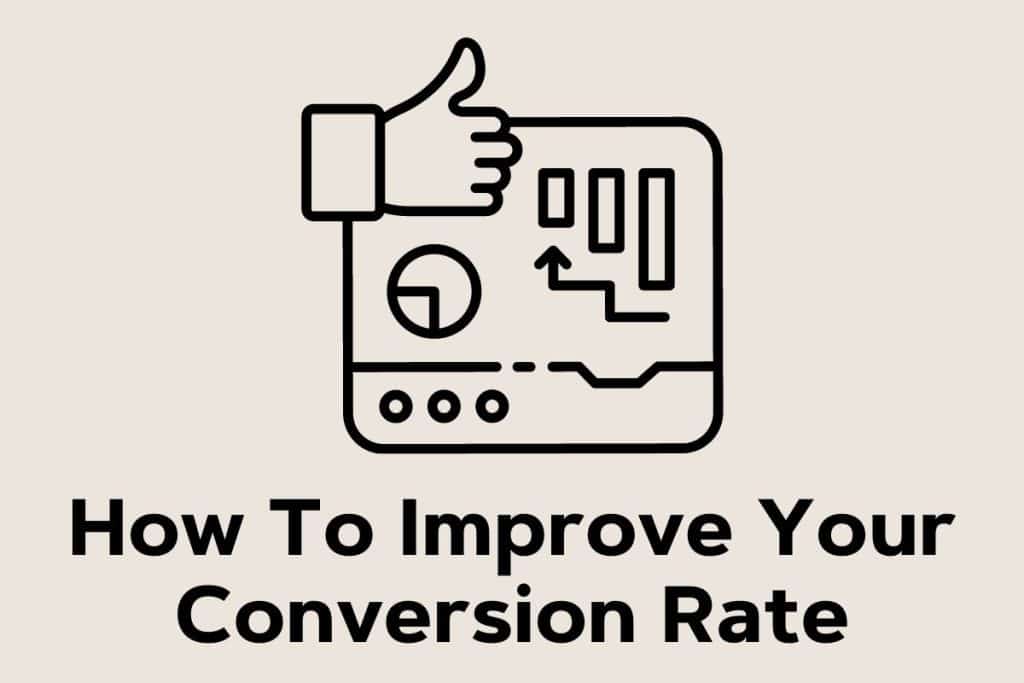
A/B Testing And Experimentation
A/B testing, also known as split testing, is a method used to compare two or more versions of a webpage or element to determine which one performs better in terms of conversion rate.
After doing a lot of media buying myself, I recommend you always start by split testing only one element.
If that’s a CTA button, create an alternative version (red button against green button) and compare them. Once you find the winner, you can compare the size of the button and then the font of the button.
You can perform a split test for any element you want.
And once you think you have optimized the hell out of your, let’s say, landing page, you can start with multivariate testing, which compares multiple variables/elements and how they interact with each other.
For example, you can check how to run an A/B test on a WordPress blog.
Minimize Cart Abandonment
If you checked our shopping cart abandonment statistics, you know the average abandonment rate is nearly 80%. That’s huge!
What can you do about it?
There are actually a lot of tricks you can implement to improve your conversion rates by minimizing cart abandonment, such as:
- Create a simplified (read fewer steps) checkout process.
- Displaying clear and transparent pricing throughout the customer journey. Almost half of the consumers say they abandoned the cart because of the extra cost (pricey shipping, additional fees, tax. etc). No surprises!
- Offer a guest checkout option so customers to purchase without the hassle of account creation.
- Displaying trust signals and security.
- Setup cart abandonment recovery email campaigns. You can send a reminder only or offer a (personalized) discount/coupon code.
- Faster shipping and clearer return and refund policies.
Personalization And User Targeting
Personalization is a powerful tool for connecting with users on a deeper level, delivering the right message to the right audience at the right time.
By leveraging personalization and user targeting, you can create a more tailored and relevant experience for your audience, leading to higher engagement, increased trust and (YUP!) improved conversion rates.
You can also use audience segmentation and target specific user groups with (extremely) personalized messaging and offers.
What’s best, you don’t have to manually do personalization and user targeting; instead, let machines do the work for you.
If you’re interested in automation, our marketing automation statistics will help you understand its potential better.
Improve Customer Support
While everyone is all about the technical aspects that contribute to improving CR, one “simple” tactic is improving customer support.
Not that this doesn’t involve using some tech (hey, chatbot statistics!), but you might have done everything you could, so it comes down to boosting your human-to-human interaction.
But in general, here’s what you can do:
- Prioritize customer satisfaction and trust
- Speed up the resolution of customer concerns or issues
- Offer valuable support and guidance (to influence their purchasing decisions)
- Effective customer support is great for acquiring new customers and retaining existing ones
- Positive customer support can generate positive word-of-mouth recommendations
- Never stop improving!
Share (More) Benefits (Not Features)
This is something I have been struggling with for a long time.
Of course, you would want to list product or service specifications and features (on the product/service page), but that isn’t necessarily what you should use to boost conversions.
Instead, focus on benefits. How can your product or service make the user’s life easier?
In short, take the feature and ask yourself, “How can XYZ benefit/help the user?”
Use benefits in your marketing messaging – because they sell better.
Eliminate Page Distraction
Cluttered website = Barely any conversion.
All those fancy animations and special effects may look cool and spark emotion, but they don’t do much for CR. In fact, they can decrease it.
By sticking to a minimalist and simplified design, you create a clear and focused user experience. You want your audience to be engaged by the offer(s), not the distractions.
Moreover, too many choices or distractions can overwhelm visitors and lead to decision fatigue.
You’ll also increase message clarity, improve user experience, project professionalism, and – yes, really – your website will offer better loading times.
Test Different Offers
Testing different offers is like unlocking a treasure trove of information.
It helps you determine what your customers love, fine-tune your value proposition and solve their pain points.
For instance, if you’re using a newsletter subscription form to generate leads, you can also use a discount-code-in-exchange-for-an-email-form and see which performs better.
This data-driven approach empowers you to make informed decisions, refine your offerings and raise conversion rates.
It’s all about delivering offers that hit the bullseye and keeping your audience returning for more.
Simplify & Optimize The Sales Funnel
If you aren’t seeing the best results, it might just be that your sales funnel is too complex, lacks trustworthiness or is irrelevant, so many potential customers are dropping off halfway through (or earlier).
There are a bunch of stuff you can do to sort out the situation:
- Reduce unnecessary steps and form fields to
- Create a clearer path and straightforward navigation
- Include trust signals and social proof
- Use landing pages to push single products and offerings
- Add a clear call-to-action
- Ensure your audience isn’t too broad
- Work on quality content (images, videos, copy, etc.)
By simplifying and optimizing your sales funnel, you provide customers with a transparent and frictionless journey that calls for more conversions.
Add Testimonials And Reviews
While I thought of adding testimonials and reviews as part of simplifying and optimizing the sales funnel above, I think they need a separate paragraph.
It doesn’t matter how good your copy is, how high-quality your videos and images are and how over-the-top your offer is – testimonials and reviews can make or break a conversion.
Over 90% of online shoppers read online reviews before purchasing. Not just that, but nearly 90% of them say that they trust online reviews and customer stories more than recommendations from friends and family.
So, do you want to improve your conversion rate? Include testimonials, reviews and ratings in your sales funnel.
Use Data Analysis And Tracking Tools
Forget about applying the above strategies to improve your CR manually. Why?
Because your competition is using software that works round the clock, and you can’t beat that with manual work.
That’s why investing in at least some of the tools (some are free) is essential, like analytics, conversion/user tracking, data analysis, user segmentation, split testing, heatmaps, conversion optimization, etc.
But choose software and tools based on your specific needs, budget and technical requirements.
Conclusion: Remember Conversion Rate!
Understanding what constitutes a good conversion rate is crucial for businesses aiming to drive success in their online endeavors.
While the ideal CR varies depending on the industry, business model, offer and target audience, a good conversion rate aligns with your specific goals and consistently outperforms industry averages.
Thus, focus on your business and improving your conversion rate, not necessarily so much what the industry/niche average CR is.
However, start by setting realistic expectations, realize those and then move forward. (Don’t set goals you can’t 100% believe it.)
In short: Set goals. Track your performance. Optimize. Apply. Repeat.

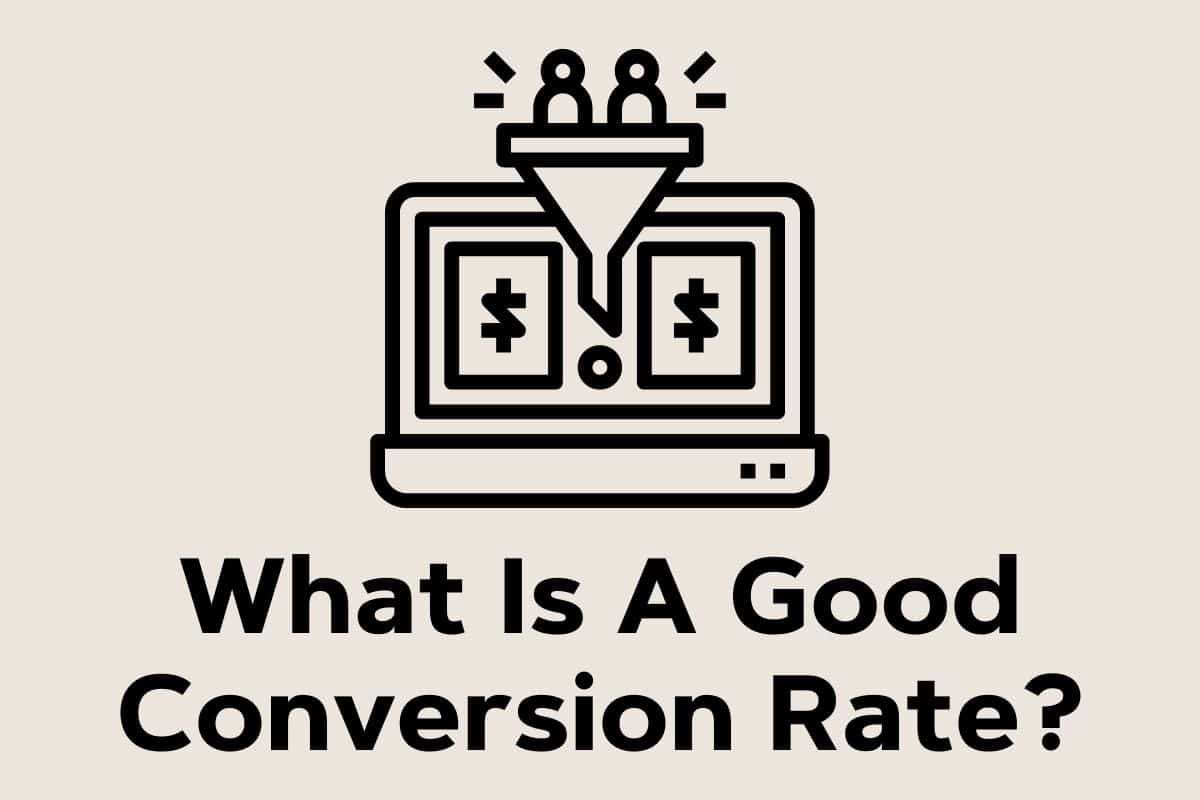
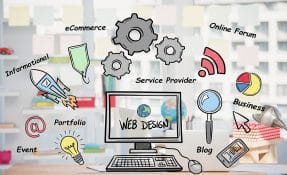
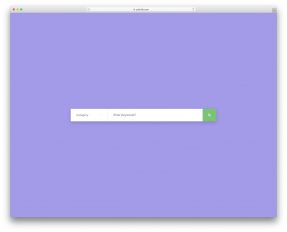
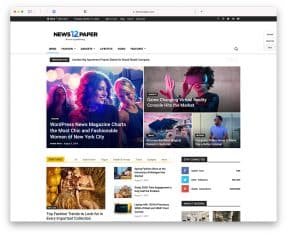



This Post Has 0 Comments